Electronics Show 2007
Electronics Show 2007
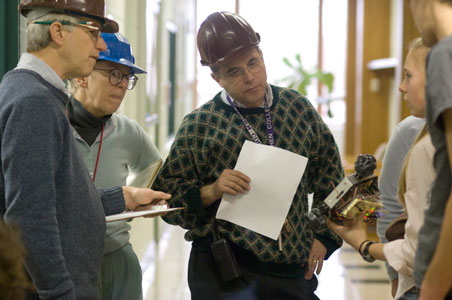
Students in the Electronics class displayed their projects for the campus and community in a grand show in the Science Hall and outside.
Projects this time included several robotic cars, a musical instrument, and a candy sorter.
The projects all used microcontrollers–single chip computers that can be programmed to respond to sensor inputs and can control outputs.
For those in the know, we used the PIC 16F88 programmed in PicBasic Pro. Many of the projects required significant mechanical design and construction in addition to the electronics and programming.
Projects
- Polaris Navigator
Elizabeth Buschert
Russell Horst
1st Place - Omnibot by Gucci
Jacob Brenneman
Tina Peters
2nd Place - π’d Piper
Becca Friesen
Kathy Steiner - Fleæ
Ben Shenk
Isaac Witmer
Jason Yoder - Entropy Reducer II
Jivan Khatry
Nick Good - LightSwitch
Haniel Goertz
Polaris Navigator
Elizabeth Buschert
Russell Horst
First Place
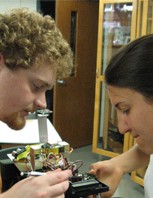
Polaris is an autonomous car that uses a Parallax GPS reciever, Devantech electronic compass, and ultrasonic rangefinders to get from its present location to a destination while avoiding obstacles. The forward speed and GPS coordinates of the destination are set initially, and then the robot is taken to a starting point. It uses the GPS and compass to set and maintain and east/west heading. It follows this heading, checking the rangefinders, compass, and GPS along the way, until its current longitude is within a certain range of the destination longitude. It then goes through the same process to get within range of the destination latitude.
- Circuit Schematic
- Program Code and a detailed explanation
Omnibot by Gucci
Jacob Brenneman
Tina Peters
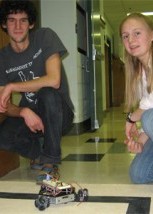
Second Place
- Circuit Schematic
- Program Code and a detailed explanation
Fleæ
Ben Shenk
Isaac Witmer
Jason Yoder
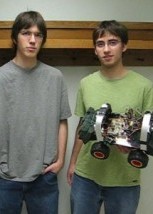
The Fleæ is constructed on the chassis of an ordinary remote control car. Ultrasonic sensors were used to determine the distance the car was from objects as it drove about. With multiple sensors, we could also get some idea of where objects were located. Using this information, our program told the car how to adjust its speed and direction in order to avoid the obstacle. A second program includes an infrared distance sensor and a compass. With these extra elements, the car can be programmed to follow a hallway wall and make 180 turn at the end.
- Circuit Schematic
- Program Code and a detailed explanation
π’d Piper
Becca Friesen
Kathy Steiner
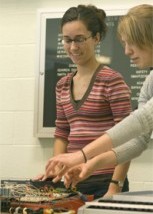
The Pi’d Piper takes MIDI signals and translates them into mechanical movements that play a recorder. Information is sent in 3 byte packets, telling our device whether a note is on or off, which note, and how loud the note is. Depending on which note is being sent, the Piper executes a certain fingering based on standard recorder fingerings using 7 mechanical “fingers”. One or two valves can open to allow air from a building supply to blow the recorder.
- Circuit Schematic
- Program Code and a detailed explanation
Entropy Reducer II
Jivan Khatry
Nick Good
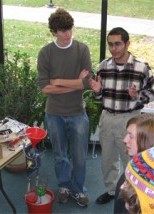
The Entropy Reducer is designed to allow a pack of spherical candy to be separated into its various colors. The candy is funneled towards a color sensor which detects its red, green, and blue frequencies. Two servomotors gates move up and down to allow one piece of candy to roll down the track at a time. Solenoid kickers are then used to separate the candy into different bins based on the readings from the color sensor.
- Circuit Schematic
- Program Code and a detailed explanation
LightSwitch
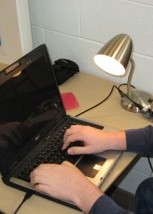
Haniel Goertz




